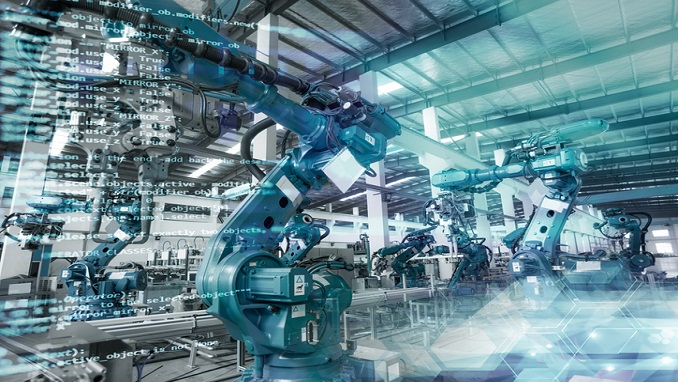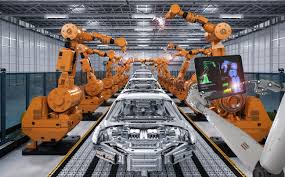Hello!
 The application of industrial robot arms has been evolving rapidly in industrial and manufacturing facilities. A recent report suggests that industrial robotics is the leading robotics sector set to experience more than 18% of growth by the year 2025. Manufacturers that intend to utilize robots in contouring the rising skills gap are driving robotics growth.
The application of industrial robot arms has been evolving rapidly in industrial and manufacturing facilities. A recent report suggests that industrial robotics is the leading robotics sector set to experience more than 18% of growth by the year 2025. Manufacturers that intend to utilize robots in contouring the rising skills gap are driving robotics growth.
An industrial robot is a typical robotic system, which industries use for manufacturing purposes. Robots are mostly used for repetitive and risky tasks.
These robots are programmable and automated. Also capable of movement. Hence, they make the jobs easier for workers.
Market Growth & Trends
The industrial robot market is a multi-billion dollar market. And the number is keep growing rapidly. Almost every company today is leaning towards automation. Therefore, the demand for industrial robots is increasing fast.
A recent study predicts that the global industrial robot market size will cross 50 billion by 2026. However, the market size was approximately 21 billion in 2020. Hence, during the period of 2021-2026, the market is expected to grow at a CAGR of more than 18%.
 The adoption of industrial robotic technology has increased the efficiency of companies. It allows businesses to produce quality products at a less price.
The adoption of industrial robotic technology has increased the efficiency of companies. It allows businesses to produce quality products at a less price.
Therefore, makes them more competitive in case of pricing, a key factor in generating sales. Besides, the robots reduce the workplace injury risk too.
According to OSHA, companies spend over $4 billion every month as compensation for workplace injuries. Robots have been helping to reduce the amount.
After realizing these benefits, companies are showing more interest in robotics. This is the reason why the market tends to grow so fast. Moreover, in the next decade, the growth rate can be doubled than the current period.
Findings from Studies
 According to some reports, many entrepreneurs are adopting service robots to facilitate the execution of new applications. The report further suggests that adopting robots plays a significant role in enhancing productivity, streamlining processes while creating a unique high ROI. This article covers some of the top robot trends that will highly influence the industrial and manufacturing industries in 2023.
According to some reports, many entrepreneurs are adopting service robots to facilitate the execution of new applications. The report further suggests that adopting robots plays a significant role in enhancing productivity, streamlining processes while creating a unique high ROI. This article covers some of the top robot trends that will highly influence the industrial and manufacturing industries in 2023.
6 Leading Industrial Robot Trends for 2025
1. Cloud Robots
Cloud computing and storage offer an individual platform capable of providing services for robotics. Once connected to the cloud, robots gain access to a data center’s advantages, including software as a service, storage, and data analytics.
Experts in the robotics industry opine that enhanced cloud software that facilitates operations between robots will be available. Consolidating operations within a single platform will enable robots to operate efficiently and execute more tasks with ease.
2. Rising use of Collaborative Robots
 Collaborative robots or cobots are built to operate beside human workers without the presence of barriers safely. These units come with advanced end of arm tooling, software, and sensors to detect possible changes within the working environment.
Collaborative robots or cobots are built to operate beside human workers without the presence of barriers safely. These units come with advanced end of arm tooling, software, and sensors to detect possible changes within the working environment.
They will then respond safely. According to experts, collaborative robots are one of the robotics divisions that will experience significant growth in 2025 and beyond. A considerable percentage of this growth is attributed to their user-friendly programmable software.
3. Artificial Intelligence-enabled Robots
Artificial enables robots are built to learn on the go. They rely on advanced software, sensors, actuators, and vision systems to gather and evaluate data from their environment as they operate and respond instantly with enhancements.
As the robot collects more data and executes its tasks, machine learning, and artificial intelligence algorithms become more compelling. Artificial intelligence furnished robots often clean equipment, transport various objects in manufacturing plants, and manages the inventory.
4. Custom-made Robots
 Today, more robot manufacturers are personalizing their industrial robot arm to meet the needs of their applications. For example, six-axis robots can be custom-made to handle multiple manufacturing applications.
Today, more robot manufacturers are personalizing their industrial robot arm to meet the needs of their applications. For example, six-axis robots can be custom-made to handle multiple manufacturing applications.
Further, manufacturers can improve them by incorporating permanent camera or robot-fixed camera systems to combine with the robot commands and develop precise, effective motions for specific tasks.
5. Commercial Drones
Innovation in the commercial drone automation sector includes the evolution of autonomous structures that can operate past the optical line of vision, advanced batteries, enhanced sensors, payloads, and lightweight objects.
For instance, 3D robotics has established a smart self-auditing drone complete with advanced automation and sensor technologies. These features make them ideal for use in the transportation, logistics, and military sectors.
6. Self-restorative Robots
 Innovations in self-restorative technologies allow robots to complete simple remedies on themselves. One of the research teams in Europe has developed robotics from flexible plastics complete with ingrained sensor components that identify damage in the structure and activate them to conduct repairs.
Innovations in self-restorative technologies allow robots to complete simple remedies on themselves. One of the research teams in Europe has developed robotics from flexible plastics complete with ingrained sensor components that identify damage in the structure and activate them to conduct repairs.
No human intervention is required during the identification and repair process.
The robots can generate new bonds across the damaged area. Based on the magnitude and location of damage, the repair process can last between minutes and a week to complete effectively.
Leading Industries to Use Robots
Almost every industry today uses robots. The works have become easier with them. However, none of the industries have used robots for their entire work. So, which industries use robots most? The following are top leading industries to use robots in 2023:
Automotive Industry
 It’s no surprise that the automotive industry uses robots the most. That’s happening since the first industrial robot was made. The automotive industry includes some heavy works. That becomes for humans. Therefore they use robots.
It’s no surprise that the automotive industry uses robots the most. That’s happening since the first industrial robot was made. The automotive industry includes some heavy works. That becomes for humans. Therefore they use robots.
Besides, the work also consists of risk as they produce engines and electrical components. So, robots help human workers to avoid risk.
Not to mention, around 35% of the total industrial robots are installed in the automotive industry.
Electronic Industry
After the automotive, the electronic industry uses robots most. The reason is obvious. To do electric works, the workers have to maintain high safety. That’s why they took the help of the robots. Besides, the work includes a lot of repetitive tasks.
Robots can be easily programmed for these tasks. Also, they cost only one time. That’s why producers are investing in robots. In the electronic industry, approximately 150k industrial robots are installed every year. The number is expected to grow even more in the upcoming years.
Metal Industry
 The use of robots in the metal industry has been increasing rapidly in recent years. The metal industry always deals with heavy materials. Therefore, they use robots to load and unload them. Besides, regular welding can be harmful to the health of humans.
The use of robots in the metal industry has been increasing rapidly in recent years. The metal industry always deals with heavy materials. Therefore, they use robots to load and unload them. Besides, regular welding can be harmful to the health of humans.
So, robots are programmed to do that kind of job to avoid health risks. Robots also help with repetitive tasks like painting, washing, etc. The number of robots installed every year in the metal industry is approximately 60k. Lately, the trend is moving upward.
Food Industry
The food industry is another leading user of robots. The most common reason behind this is to maintain hygiene. Workers do a lot of works with their hands. So, sometimes it becomes tough to maintain full hygiene. So, robots are programmed to do that.
Besides, the use of repetitive task is huge in this sector. Weighing the same amount of ingredients and mixing them every single day causes boredom for workers, which leads to fatigue.
Therefore, different functional robots. Moreover, a lot of restaurants are also using robots to serve food to their customers. It’s been a new trend and has become popular instantly. Around 30k robots are installed in this sector every year.
Chemical Industries
 The chemical industry is one of the most versatile industries. Therefore, they use AI-generated robots heavily. Though almost every industry prefers AI robots today, they’re best suited for versatile works. Approximately 25k robots are installed in this industry in the previous year. The number is expected to rise in the future.
The chemical industry is one of the most versatile industries. Therefore, they use AI-generated robots heavily. Though almost every industry prefers AI robots today, they’re best suited for versatile works. Approximately 25k robots are installed in this industry in the previous year. The number is expected to rise in the future.
FAQ
What are the current trends in robots?
Robots are getting smarter day by day. AI-generated robots have been revolutionary as they have the ability to make decisions. Therefore, the current trend in robots to use them besides humans to get the best solutions to different problems.
What is the smartest robot in the world?
Sophia is the smartest robot in the world. She uses artificial intelligence to do her tasks. Sophia can communicate with people in different ways and also generate facial expressions according to the situation. These things make Sophia so smartrobot in the world.
Which country has the most industrial robots?
Singapore is the top leading country to use industrial robots. According to a study last year, Singapore has 9180 units of robots per 100k employees in 2019. In this country, the electronic industry uses most robots. Around 75% of robots in Singapore are installed in the electronic industry.
Also read:
- How to Serve an Eviction Notice Online
- Porch Light Safety: Should You Leave It on or Off?
- 5 Steps to Turn Blog Readers into Customers
Finally
 Apart from their enhanced functionality, industrial robots are fast becoming user-friendly and easy to program. They are also becoming smaller and more affordable, allowing mid-sized manufacturers to use them in many supply chain applications.
Apart from their enhanced functionality, industrial robots are fast becoming user-friendly and easy to program. They are also becoming smaller and more affordable, allowing mid-sized manufacturers to use them in many supply chain applications.
With robots executing multiple tasks round the clock, humans can now focus on more valuable roles. Next-generation robots will come in handy to manage a significant percentage of the mundane tasks, which will facilitate substantial savings.
Companies can then invest part of their savings in more valuable roles. Instead of replacing human workers, robots will give them a chance to focus on improving their careers to better their companies.
Thank you!
Join us on social media!
See you!






